|
Posted by Romy the Cat on
07-23-2007
|
|
Taras Oleynk aka “ML8” sent me a couple months ago his measurements of different driver line-level tubes including the Melquiades’s diver tubes – the 5E5P. I am posting his data here with his permission, including Taras’ statement that is JUST PRELIMINARY RESULT, and the final testing of DIFFERENT PREAMP TUBES will be available at his site in a near future. (will be posted when available)
Taras used the 6E5P slightly different then it being used in Milq. He has 135V on plate and loads it to 25K. In Melquiades the 6E5P loaded against 15K and has 200V on plate, running 3.4V bias. Still, I found that the Tara’s measurements are indicative. You will be much surpassed to compare this data with many other drivers’ tubes that Taras have measured and documented in the identical fusion… Also, Taras claims that he have developed a methodology how to interpreter the result in hierarchical manner. It will be very interesting to learn about it future…
The Data File: http://www.goodsoundclub.com/PDF/6E5P.pdf
The ML8’s Measurements File: http://www.goodsoundclub.com/Docs/6E5P.xls
The files in Russian and I took liberty to translate it in English where it was necessary. Rgs, Romy
|
|
|
|
Posted by Romy the Cat on
07-30-2007
|
|
I think it should be somewhere posted for my and perhaps for others future references. Here is the setting for testing Melquiades' single-stage tubes on Hickok 580/580A tube testers. To test the tube as a driver for a full Milq (two stages) set Bias 3.4V
6E5P and any of its derivatives:
AFHO-BEDO
Plate - J (190V)
Screen -J
Filament 6,3V
Plate Current – Adjust Bias to 30mA
Bias - 2.5-3.4 V
Range - C
Min GM > 16000
6E6P and any of its derivatives: DEBO-GJAO
Plate - J
Screen -J
Filament 6,3V
Plate Current – Adjust Bias to 30mA
Bias - 2.5-3.4 V
Range - C
Min GM> 16000
|
|
|
|
Posted by hagtech on
12-03-2007
|
Romy, I tried out a 6e5p as a driver tube in a PP 2a3 amp (was using a 7788 for driver). Well, knock my socks off! The amp went from 6 watts to 8 watts! Distortion dropped a tad, but mostly it was more signal swing. I could drive well into A2 region. Have not heard it yet, but so far this is very promising.
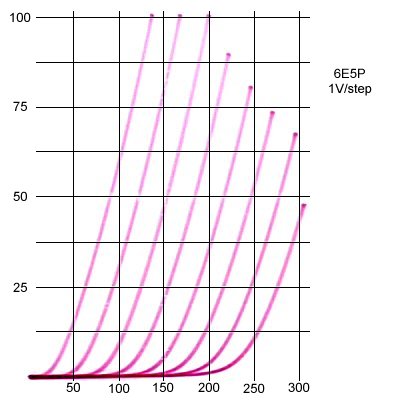
jh
|
|
|
|
Posted by Romy the Cat on
12-03-2007
|
|
Why do you think I bout a 1000 of them and closed to the rest of my life my interest in driver tubes?
Still, the 6E5P should not be measured as a driver but heard as a driver – the beauty in this tube is in its sound.
I do not know why it gave to you more power. It is a regular 32-36 times gain, it means with 4V bias you can get a lot of voltage from this tube with no problems. I uselessly drive it with 200V and you might drive it as hot at 6.5W, with 8.5W max but I would not go there. The only concern that I have, since I knew that you will be juts measure them, if I did not send you the 6E5P-E. The 6E5P-E is impulse venison of the tube and although it measures virtually identically but it does not sound as good, it is ¼ smaller as well.
BYW, the benefits that you got were so far not the 6E5P advantages but you juts stopped to use absolutely not appropriate tube (7788) to drive your 2a3. John, I am very much not in position to argue with your about tubes but to use 7788 at line voltage as … a driver is absolutely beyond my believe in mankind sincerity… :-) The Cat
|
|
|
|
Posted by Paul S on
12-04-2007
|
|
So what's wrong with the 6SN7, apart from the high prices fetched by good ones? If building a 2A3 amp for personal use, it seems a likely choice. I do not know the 6E5P, but I do love the tone of the 6SN7, and I especially like it driving a 2A3, not that I have any use for a 2A3 these days. For another thing, the 6SN7 is not only capable of amazing grace and delicacy but can be quite "hard" when it called for, and moreover it can pass its qualities right through the 2A3.
Jim, you probably know that George Wright uses a 6SN7 to drive a 2A3 well into A2, which IMO works pretty well in that particular case, especially within the simple Class A envelope, where it seems to "create a sense of headroom" that few 2A3s have with complex material. Obviously, the downside is truly horrendous distortion at limit...
Best,
Paul S
|
|
|
|
Posted by hagtech on
12-04-2007
|
The 6sn7 is a fine amplification tube for use in preamps or gain stages, but it has way too high of an output impedance for driving power tubes. This is my personal preference. It also depends greatly on the topology. Maybe George used it as a cathode follower?
For me, the best tube to drive a 2a3 is another 2a3, but that gets you nowhere.
My new amp is a push/pull/parallel, where I can dial in the ratio between single-ended (in parallel) operation and differential operation. One mode has a lot of even order harmonics, the other odd. The differential mode has better PSRR, but still to me, preserving harmonic balance is more important. The advantage to this method is that you can use a regular output transformer, no dc flux to worry about (or parafeeds). This circuit also employs a new trick I invented to provide inherent self-balancing of unmatched tubes. Using a CCS for each cathode maintains a perfect dc current balance in the transformer. Also, tube bias does not have to be adjusted (nothing does!). All this is done without servos or opamps or feedback or any of the usual garbage. However, it does require an interstage transformer. I run an SE driver stage with parafeed CCS to the interstage. This is where the super low plate impedance of the 6e5p comes in handy. It is the only way to drive the load with power, grace, and bass down past 20Hz. A 6sn7 in this position would fall flat on its face.
Basically, there is no right answer. The 6sn7 might work in another circuit. Just not mine. For driving output tubes I prefer the interstage tranny, as it does not suffer bias shift across a coupling capacitor caused by grid current.
jh
|
|
|
|
Posted by JJ Triode on
12-04-2007
|
|
...he uses one section of the 6SN7 for gain, the other as a cathode follower to provide current drive to the grid of the output tube. On some of his monoblocks he uses a dissimilar dual triode like a 6DN7 or 6EM7 this way, with the lower gain-lower plate resistance section as the cathode follower.
|
|
|
|
Posted by drdna on
12-04-2007
|
 Paul S wrote: Paul S wrote: | | So what's wrong with the 6SN7, apart from the high prices fetched by good ones? If building a 2A3 amp for personal use, it seems a likely choice. I do not know the 6E5P, but I do love the tone of the 6SN7, and I especially like it driving a 2A3, not that I have any use for a 2A3 these days. |
|
I have a pair of amps that utilize this combination of 6sn7 into 2a3. My impression of it has always been that it is good enough at allowing one to connect to the Sound, but in terms of sounds it is a little lacking. It seems to hide details and make everything a bit strained. I have always felt this is a case of two great things that do not go so great together, unlike Reese's Peanut Butter Cups.
|
|
|
|
Posted by Paul S on
12-04-2007
|
Adrian, I agree that SETs generally have issues such as you describe, and moreso the small ones, especially at the frequency extremes, and at saturation, which tends to occur all too soon, IMO. But I have not sourced these problems back to the 6SN7, or even the 6SN7/2A3 pairing, which I find capable of great contrasts, at least within the all-too-obvious limitations of the small SET.
Are your amps Wright SETs? I enjoyed my time with those amps, found more to like than dislike, apart from the power limits/struggles with my present speakers. I the Wrights work best with top NOS 6SN7 and the rough-and-ready Sovtek 2A3, and that 2A3 does like a good, hard kick in the pants. Vaunted RCA is nice but too tame for me, not the best lens for the 6SN7, IMO.
Besst regards,
Paul S
|
|
|
|
Posted by Romy the Cat on
12-04-2007
|
|
Sometimes my time will come and some of you will try the 6E5P as a driver, properly used. Then, if this person has a sensitivity and rudimental audio intelligence to recognize some unique 6E5P’s sonic signatures then he will find interested to reread what I have written about the sound of this tube in past. Who, knows, perhaps then the terms like “dynamic viscosity” would sound not so alien for the 6E5P-evolved…
|
|
|
|
Posted by drdna on
12-05-2007
|
 Paul S wrote: Paul S wrote: | | Adrian, I agree that SETs generally have issues such as you describe, and moreso the small ones, especially at the frequency extremes, and at saturation, which tends to occur all too soon, IMO. But I have not sourced these problems back to the 6SN7, or even the 6SN7/2A3 pairing, which I find capable of great contrasts, at least within the all-too-obvious limitations of the small SET. Are your amps Wright SETs? I enjoyed my time with those amps, found more to like than dislike, apart from the power limits/struggles with my present speakers. |
|
Well Paul, these are not Wright amps. I put these together myself. The characteristic may be more the circuit than the tubes? I haven't played around so much with this aspect to know. Just my observation.
 Romy the Cat wrote: Romy the Cat wrote: | | Sometimes my time will come and some of you will try the 6E5P as a driver, properly used. Then, if this person has a sensitivity and rudimental audio intelligence to recognize some unique 6E5P’s sonic signatures then he will find interested to reread what I have written about the sound of this tube in past. Who, knows, perhaps then the terms like “dynamic viscosity” would sound not so alien for the 6E5P-evolved… |
|
Well, and I have a dozen of them sitting here next to my desk while I am building my Milq amp s-l-o-w-l-y so I guess I will discover my audio intelligence level sometime after the New Year.
Adrian
|
|
|
|
Posted by Romy the Cat on
12-05-2007
|
 drdna wrote: drdna wrote: | | Well, and I have a dozen of them sitting here next to my desk while I am building my Milq amp s-l-o-w-l-y so I guess I will discover my audio intelligence level sometime after the New Year. |
|
That is so cool that you Adrian and Jim look like will try to drive with Mil’s input stage the 2A3; I never hear it and I would be very exited if I have change to do so, or at least to hear from other how it was. I would even like people try AD1 instead of 2A3, though the 2A3 is very good tube as well if one have right loudspeaker.
I do not think that I will do it as to me 8W if not here and not there, well, if I move in a much larger room where my single-stage amp will not have enough power (2.5W) then I might consider something like this…
My only concern with all of you guys experimenting with 6E5P-2A3 is that 6E5P is 30-35 time gain tube and 2A3 is relatively low biased tube. Driving with 6E5P-2A3 tandem a 110dB sensitive MF driver is fine but driving with sub 100dB sensitive upperbass driver might be problematic. With moderate 2V on the 6E5P grid the 2A3 dive into class A2 – and it will be very quite frequently or in some cases continues. If you wish then ask Dima to share his “kinky” invention of “coupling capacitor class A2 conditioner”– it might be a useful thing.
Anyhow, please share your thoughts about the 6E5P driver. Do not forget that the milking bias for 6E5P around a grid resistor using Gas tube voltage’s dumping was invited to make the 6E5P to sound right against the 6C33C power triode. It is possible then other output tube might demand a different biasing application for 6E5P, I have no judgment about it as I did not try other output tube. Here is where you guys come alone… The caT
|
|
|
|
Posted by Romy the Cat on
01-02-2008
|
|
Here is a document in Swedish language that describes its authors’ view on 6E5P. Since the author extensively use a park of Russian tubes I presume that he is Russian descent.
http://www.romythecat.com/pdf/6E5P_Swedish.pdf
If you do not speak Swedish (I do not) then you might use this tool for semi-comprehendible translation (if you need it)
http://www.systransoft.com/
The document has a number of typical 6E5P applications. Also I am not necessary agree with many of them but it well illustrates the virtuosity of this driver The caT
|
|
|
|
Posted by hagtech on
02-20-2008
|
I got my second version of new power amp up and running, this time using the 6E5P Romy recommended. Output tubes are 2A3. Amazingly, this amp runs at 0.12% distortion at 1W. No feedback anywhere. It is simple two stage amp running wide open. At full 6W power, distortion is still under 0.5%. I believe these results are because of the driver tube.
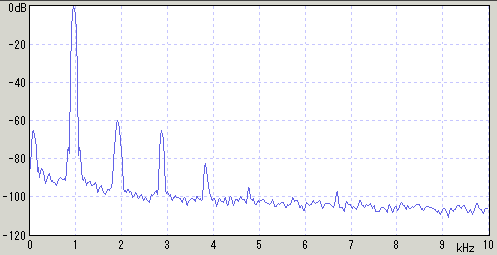
jh
|
|
|
|
Posted by hagtech on
02-20-2008
|
Oh, I forgot, the input sensitivity is roughly 0.95Vrms. At 6W power, the output sinewave looks like this:
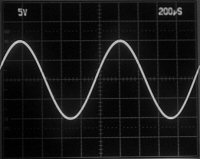
When driven into overload, a +6dB input (1.9Vrms) generates 13W output and it clips softly like this:
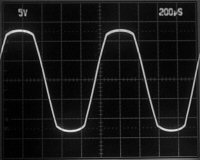
The sinewave should be reaching top and bottom of scope grids. But hey, it remains very well behaved and does not clip hard like an SS amp.
jh
|
|
|
|
Posted by Romy the Cat on
02-20-2008
|
|
Jim, what is operational point of the 6E5P, what it drivers (how it coupled) and how do you bias the 5E5P? BTW, the clipping at the bottom is very good, very symmetrical. Try to measure which stage clips first: the driver or the output stage. One more thing: with 6E5P you will have very different amp on 2A3 then what you usually get from this tube. Most of the people spray myths about all those DHT 2A3, 45, 300B and alsike but in reality it is possible that they juts deal with very differently-bad drivers and I have heard many typically 3-stage dead amps with DHT. The 6E5P is a different ballgame but it has not swings 100VAC in single stage but it has actually sound. I do not know if you got sound also sans you do not write about sound. I hope you will.
|
|
|
|
Posted by Paul S on
02-20-2008
|
Not to mention the "overload"!
Jim, I have never seen that before.
I happen to like the 2A3 a lot; nice tone and great bass. I only quit on it because of the power limits.
Congratulations.
AC or DC heaters?
If you haven't yet tried the Sovtek 2A3, I highly recommend it.
Best regards,
Paul S
|
|
|
|
Posted by hagtech on
02-20-2008
|
I run the driver tube at 170V @20mA. I don't think you need to run this tube at high current. It is very linear with wide signal swings at this bias. I can get roughly 70Vrms out of it. Output stage clips first, driver continues with perfect waveforms well into clipping of output. Oh, using transistor constant current source on driver plate. Output is push/pull parallel SE. I can set the ratio between single-ended and differential modes via a resistor value. Suprisingly, best performance was with almost all SE parallel. I figured more of the differential mode would be needed, as least per WE 93A schematics (their idea).
I run the driver through cap to SE/PP interstage tranny. The tranny is required for my new topology, which has CCS on both output tube cathodes, hence allowing good operation even without matched tubes. No bias adjustments are necessary, both 2A3 always run at 50mA. If both working, then voltage across 2A3 is about 235V. I don't get much power, but this is more of a sonic sweet spot. Better to give up a watt or two. Output stage continues to run even if one of the 2A3 is pulled.
All heaters are AC (I think DC is bad for a DHT). Output noise is 0.16mV A-weighted. Measurements are with the cheap Sovteks. The main drawback of this design is a low damping factor. Output impedance from the 9 ohm tap is 3.5 ohms. That's pretty dang high. It is because the rp of 2A3 at this bias is about 1k ohms. It is not the most powerful output tube. More elegant than robust.
At the moment, my listening setup is in total disarray. I sold everything I had and am starting over. Difficult to ascertain sonics as I have no other working amplifier to compare it to. The speakers I have are a bad fit, and tweeters are new with only an hour of break-in so far. Plus I did crossover mods. Basically, everything is an unknown. I have only one channel of amp, which make it difficult for me to listen. So far, it sounds thin and weak to me. Nice and clear on vocals, but thin. The treble coming out of the speakers is slightly harsh. I don't think it is the amps, but I cannot prove it yet. Should take me about a month or two to get parts to make up a matched pair of amps. Then maybe I can get more serious with sound.
Oh, bandwidth is 6Hz to 25.5kHz. Not very high, and this is purely a limitation of my interstage tranny. The driver alone runs to perhaps a megahertz. The 10kHz waveform is funny, so I made a 5kHz one, which you can see the nice response. I underdamp it a little in an attempt to maximize bandwidth. That overshoot is not from feedback, but by the ringing between secondary leakage inductance and grid capacitance (and circuit strays). I spent a lot of time optimizing this tuning.
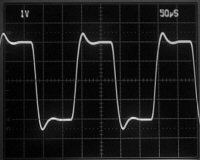
jh
|
|
|
|
Posted by JJ Triode on
02-20-2008
|
Jim,
Do you plan to develop this amp to a commercial product? Is the IT up to the job, or if not, are better ones obtainable?
Paul,
The low distortion may be partly a cancellation effect in the even orders. Even so it looks very clean, almost nothing beyond 4th harmonic (I'm assuming the fundamental was at 1kHz?)
The Sovtek 2A3 is fine, but the Shuguang 2A3C is much better for only a little more $.
|
|
|
|
Posted by Romy the Cat on
02-20-2008
|
 hagtech wrote: hagtech wrote: | | I run the driver tube at 170V @20mA. I don't think you need to run this tube at high current. It is very linear with wide signal swings at this bias. |
|
Good operation points for use it as a driver. You might what to jump voltage to 200-210V and drop current a bit as it will give you higher bias and further up the input stage from a danger of A2.
*** I can get roughly 70Vrms out of it. Output stage clips first, driver continues with perfect waveforms well into clipping of output.
Is it the output driver that clips of the output transformer? Looking at the very soft clipping it looks like it was your DTH. Dima taught me that in a properly designed amplifier a transformer should clip before the active stages.
 hagtech wrote: hagtech wrote: | | Oh, using transistor constant current source on driver plate. Output is push/pull parallel SE. I can set the ratio between single-ended and differential modes via a resistor value. Suprisingly, best performance was with almost all SE parallel. I figured more of the differential mode would be needed, as least per WE 93A schematics (their idea).
I run the driver through cap to SE/PP interstage tranny. The tranny is required for my new topology, which has CCS on both output tube cathodes, hence allowing good operation even without matched tubes. No bias adjustments are necessary, both 2A3 always run at 50mA. If both working, then voltage across 2A3 is about 235V. I don't get much power, but this is more of a sonic sweet spot. Better to give up a watt or two. Output stage continues to run even if one of the 2A3 is pulled. |
|
Jim, I certainly have no qualifications to be critical in what you do from a technical perspective but from point of a common sense, that I definitely possess, I am very skeptical about what you are trying to do. I am critical not about YOU do but about the entire objectives of the type amps that you are trying to build. Let presume that sound of amp is coming from the gain/driver stage (you might degree but it is my debatable position). If so, then the output stage is necessary primary to develop current. People do not use high efficiency load but what to use low power output stages and in order to rectify it they parallel the output stages, defeating the entire idea of SET purity. With a prober driver and properly used output stage it is very possible that output stage does not matter. What matters is a correspondence of the output stage to the load demands. If so, then why instead of going for push/pull, phase splitter and other unnecessary inventions juts do not take more capable current driver, or in other word to get more powerful tube? The 2A3 might be a nice tube but what are you planning to drive with 3W? Some kind MF channel with sensitivity over 106dB?
 hagtech wrote: hagtech wrote: | | All heaters are AC (I think DC is bad for a DHT). Output noise is 0.16mV A-weighted. Measurements are with the cheap Sovteks. |
|
… and I wish that everyone do the same. The DC on heaters must not be used for power amps. I was pissed when I saw Lamm ML3 used DC on heaters… Talking about the smelling roses in gas masks…
 hagtech wrote: hagtech wrote: | | The main drawback of this design is a low damping factor. Output impedance from the 9 ohm tap is 3.5 ohms. That's pretty dang high. It is because the rp of 2A3 at this bias is about 1k ohms. It is not the most powerful output tube. More elegant than robust. |
|
The damping factor? What do you what: you use a low power tube with huge plate impedance. This thing, from my point of view, should not drive anything under 1000Hz, unless you listen it in a closet with over 105dB sensitivity.
 hagtech wrote: hagtech wrote: | | At the moment, my listening setup is in total disarray. I sold everything I had and am starting over… |
|
Too bad, if you have a stable playback then I'll propose you to use a simplified Milq biasing model and then to pay attention to what happened to sound.
 hagtech wrote: hagtech wrote: | | Oh, bandwidth is 6Hz to 25.5kHz. Not very high, and this is purely a limitation of my interstage tranny. |
|
It is what I meant to ask. The 25.5kHz as full power is not just very good but exceptional, not to mention 6Hz which is outstanding. Sorry, I just do not believe that you get this numbers. Take you amp, load it to your nominal load, feed it with 1kHz and rise the input voltage until you see the very first signs of clipping. Then, without touching the voltages dial of your generator, lower the frequency. I do not believe that at the same amount of power that begin to clip 1kHz you will go down to 6Hz and up to 25kHz. If I’m wrong then please educate me about your OP transformer…Rgs, Romy the Cat
|
|